


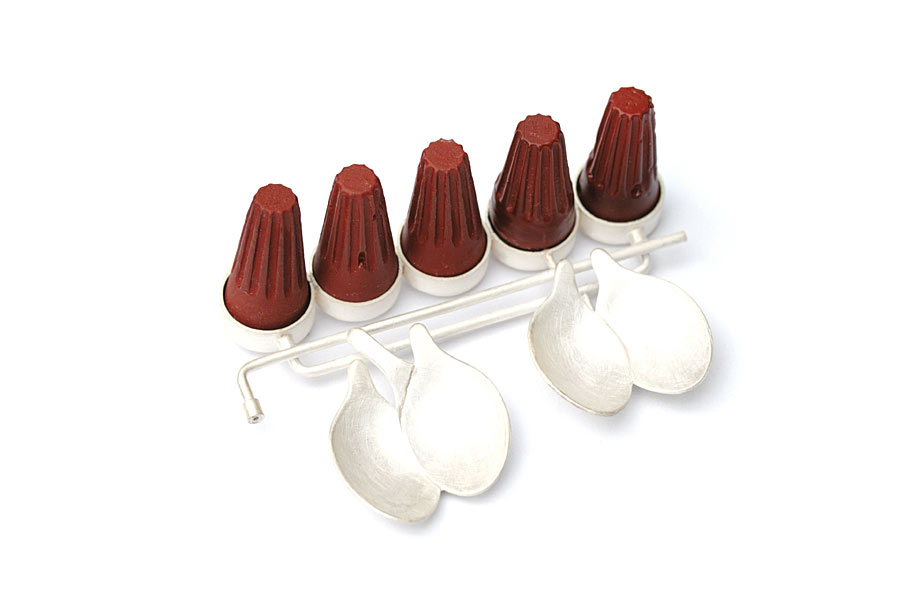
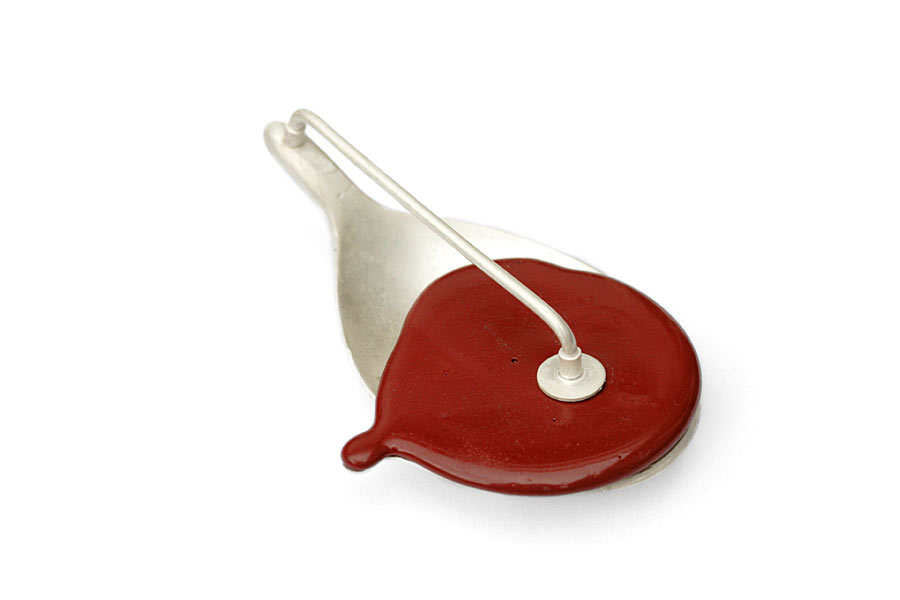
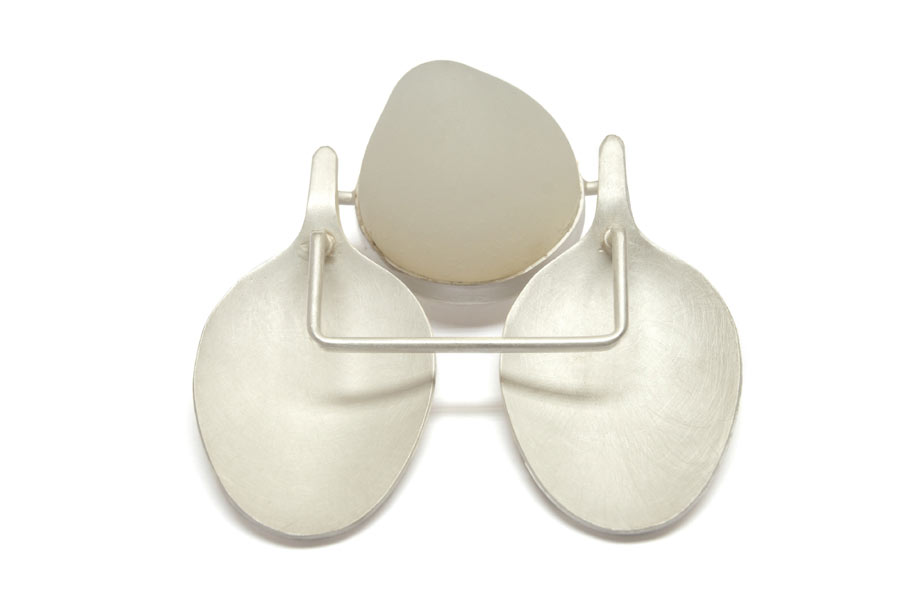
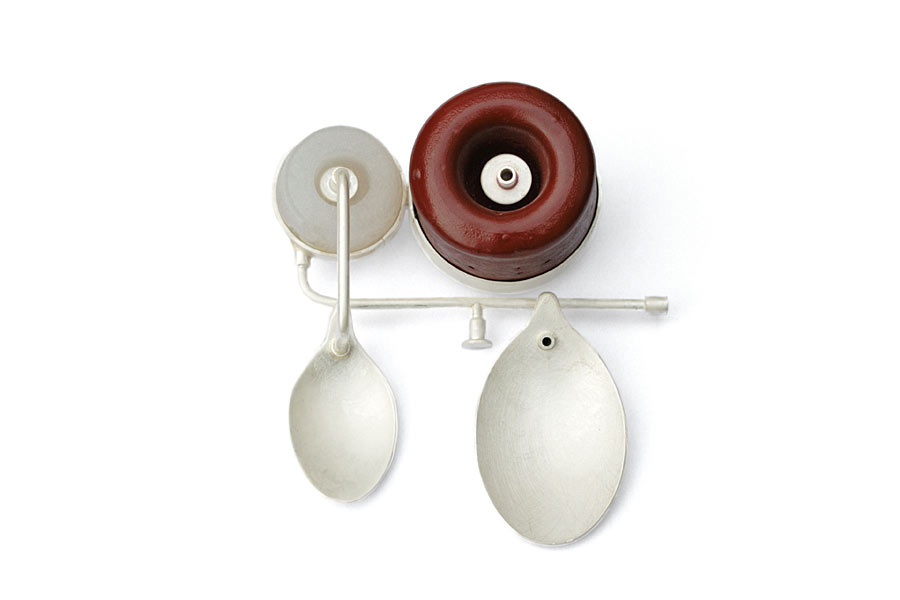
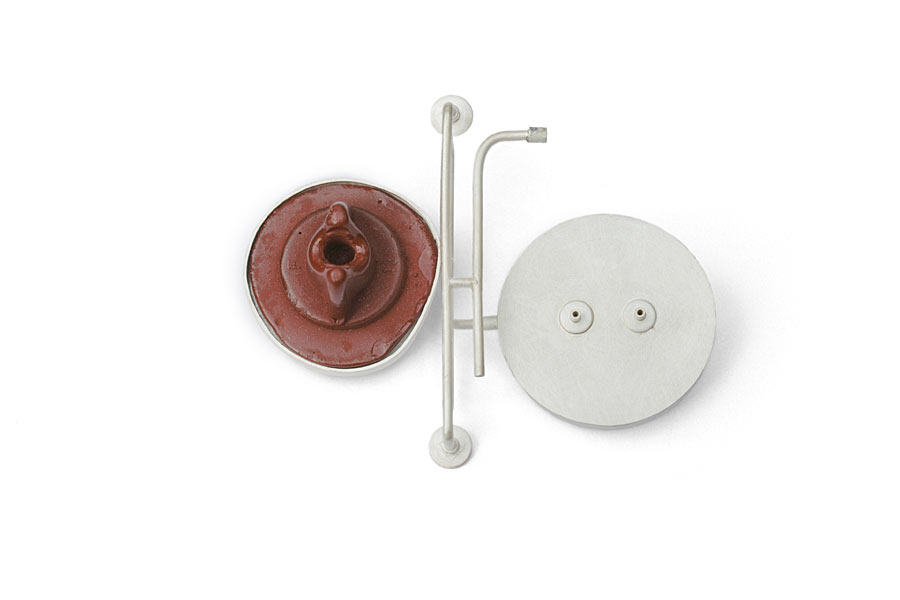






| Continuum
A continuum is a line with no beginning or end, such as the circle, the Möbius strip or the snake biting its tail. This theme has inspired numerous classics in the recent history of jewellery making, as evidenced in the work of Otto Kunzli, Emmy van Leersum, Gijs Bakker and Bernhard Schobinger. With this premise in mind, I would like to take a closer look at Katja Prins's jewellery. The unbroken line can also be heard in Bach's music, which to this day offers sustenance to many composers, including Philip Glass and John Adams. As I write this, I am in fact listening to Glass's works for solo piano to speed me along. They are variations on a theme, which seem to endure indefinitely in time. The pieces in Prins's Continuum collection are wearable miniature works of art, compositions in matt silver, milk-white silicon rubber and blood-red sealing wax, blending visual art and scientific progress to create a complete whole. On this subject, Prins says, 'My work is about the relationship - intimate or otherwise - between human bodies and mechanical devices, medical and other technology, and industry. With this work, I want to tell stories about the body as an object to be manipulated, as an instrument/machine - instruments/machines as extensions of the body.' This is an ancient ideal that has its roots in the Italian Renaissance when artists wanted to capture and understand the complex world in which they lived right down to its minutest details. Most important of these was the uomo universale Leonardo da Vinci whose attention was focused both on living people and on technology. With his anatomical studies, he was one of the first artists to map out the inner and outer human body. In addition, he was a brilliant inventor and technician whose studies of running water and a helicopter were far ahead of their time. In the recent past, the French architect Le Corbusier spent his entire life designing a constructed space springing from analyses of avant-garde art, technical innovation and the giant leap forward it had resulted in, and modern thinking about society. The Continuum series came into being in Prins's atelier, a traditional artist's studio. The small, high space is in an old building and contains a bench, numerous tools and materials, and shelves of books. Photocopies offering inspiration for the artist's creative process are displayed on the walls. As is so often the case with artists, these images are a visual aide-memoire, inescapable while work is being done. Before Continuum, there were photographs of industrial archaeological objects, such as steam pumping stations and cracking towers from the petrochemical industry as documented by the German photographer team and married couple Bernd and Hilla Becher. Far more important were images of organs and arterial systems familiar to us from books on biology and old engravings of anatomy lessons. Finally, there were also pictures of medical models made of papier mâché and plaster, and advanced medical equipment like an artificial heart and pacemakers. Continuum is an abstract synthesis of art and technique in high relief. The collection, which consists of about twenty brooches and a handful of rings, has its roots in earlier work and now seems to look ahead to Prins's very latest creations. The pieces are other-worldly objects that mainly raise questions. Naturally, we recognize pipes as such, but the oviform elements are harder to interpret. Are they flower petals or shells, or do they have something to do with eggs? On closer inspection, these elements prove to have been the bowl of a spoon, the handle of which has been sawn off. Sometimes we can still make out parts of it in a rudimentary way, but it is unrecognizable as such. Prins has rounded it off so that it looks like a drop, as if the silver were still in liquid form. Describing this paradox would require a yet unknown word which has the same dualism as 'inside out' or 'upside down'. The polarities of hard/soft and solid/liquid are reinforced by the combination of silver, plastic and sealing wax. The sealing wax in particular is a material full of history and significance. It has been used to seal and authorize, and as proof of authenticity. Prins achieves powerful results with the wax, creating brooches where it has coagulated while in the process of dripping away, like the silver described above. There are also rings with a seal of wax, thus turning the world on its head. Yet a clear polarity is still plainly visible. The red mass, which so oddly seems like clotted blood, contrasts well with the white, colourless silver. Prins herself calls the silver 'listless'. The spoon represents the 'tool', a civilized extension of the hand with which we partake of food to sustain ourselves. The spoon is also used to administer medicine like cough syrup. Prins does not see the spoon as a surrealist objet trouvé but purely as preformed material, a semi-finished product for her works, in which the original meaning of the function, somewhat concealed, is retained. While it may seem strange to use a spoon as a piece of jewellery, there are numerous examples from the past of spoons being worn as insignia. From the sixteenth century, people would take their spoons with them when travelling; spoons were an important personal possession often carried in a case or etui. But they were also worn distinctly on the body. One of the finest examples can be seen in Hieronymus Bosch's panel The Pedlar, in which a spoon hangs from the basket on the pedlar's back. There are also sixteenth- and seventeenth-century prints in which spoons are depicted in the hats of travellers and the sick, as if they were pilgrims' badges. Unfortunately, the exact meaning of these spoons has not come down to us. The meaning of Prins's pieces is not clear or unequivocal either. They are ambiguous objects to be worn on the hand as an extension of the finger or frontally on the chest as a mirror of one's inner self. She prefers to keep the beholder guessing with her work: 'I think astonishment is important because it stimulates the imagination. I don't understand many of the things that fascinate me, but I can still marvel at them. I can then add my own style to the fantasy.' The pictorial elements making up the work are like musical notes that have been arranged to form a harmonious whole like a fugue full of chords and counterpoint. Dissonance is never heard. Occasionally, the void between the elements does provide a pleasant sense of repose. The pieces making up the Continuum series only really come into their own when they are worn. 'After all, man, more particularly his body, is the measure of all things,' says Prins. The empty spaces in the works are filled by a living being. The pipes are then connected to the wearer's own circulation like bypasses. The pieces absorb energy and are transformed from purely decorative elements to advanced medical objects to which Prins has added poetry, life and, most importantly, beauty. Thimo te Duits, design curator Museum Boijmans Van Beuningen, Rotterdam, NL Photography: Francis Willemstijn |